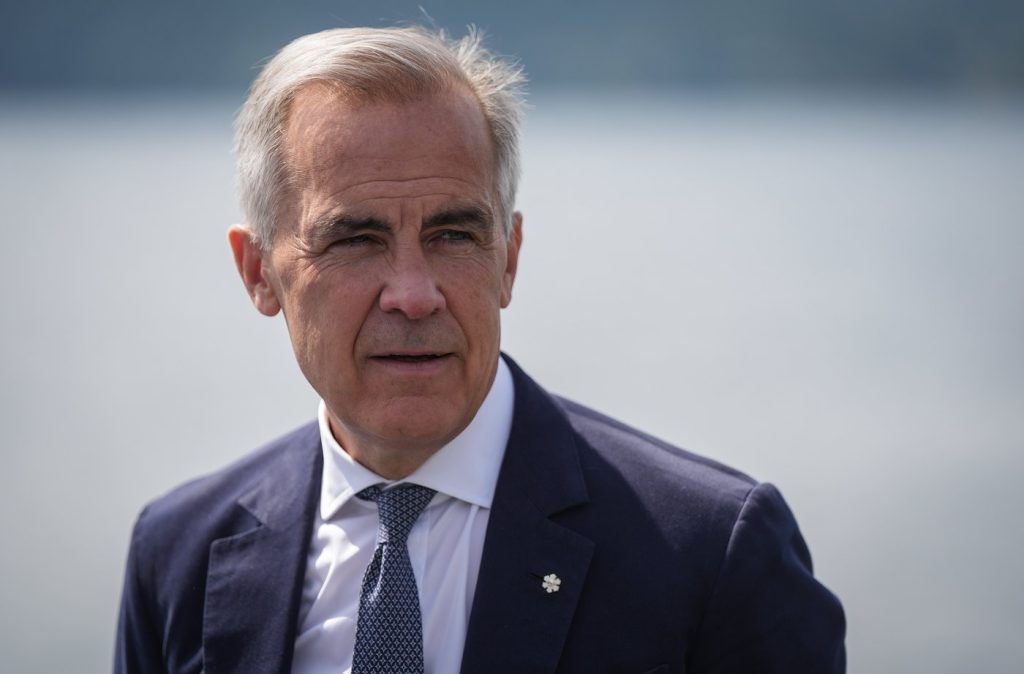Here is a roundup of stories from The Canadian Press designed to bring you up to speed…
Prime Minister Mark Carney Scheduled to Visit B.C. Interior
Prime Minister Mark Carney is set to visit Kelowna, British Columbia, on Tuesday for an announcement at a local lumber facility. This visit follows his participation in the Vancouver Pride parade over the weekend and a tour of a military facility on Vancouver Island on Monday. During his time in Nanoose Bay, near Nanaimo, Carney inspected the Canadian Forces Maritime Experimental and Test Ranges facility alongside officials from the Canadian Navy, including Vice-Admiral Angus Topshee, the Navy Commander, and Commanding Officer Craig Piccolo from the testing facility.
On Sunday, Carney met with British Columbia Premier David Eby and representatives from the Vancouver Fraser Port Authority. His visit to the province comes amid increasing tensions surrounding the long-standing softwood lumber dispute between Canada and the United States. The U.S. has imposed anti-dumping duties on Canadian softwood products, a move the British Columbia Council of Forest Industries has criticized as “unjustified and punitive trade actions.”
Vancouver Island Wildfire Grows in Size
The BC Wildfire Service has reported that the Wesley Ridge wildfire on Vancouver Island has expanded to encompass over five square kilometers. Numerous fire departments across the island are actively working to contain the blaze to safeguard properties and structures surrounding Cameron Lake. Fire information officer Madison Dahl indicated that while the fire is now categorized as a “wildfire of note,” its growth was limited early on Monday due to the efforts of helicopters using night vision equipment to drop water on hotspots and along the fire’s perimeter.
Fire crews are concentrating on preventing the wildfire from spreading and disrupting traffic on Highway 4. Currently, nearly 400 homes in the area are under an evacuation order, while an additional 230 homes are on high alert, ready to evacuate at a moment's notice if necessary.
Air Canada Flight Attendants Vote on Potential Strike
Air Canada flight attendants are nearing the end of the voting process for a strike mandate from their union. Voting began on July 28 and concludes today. This follows a failed conciliation process between the Air Canada component of the Canadian Union of Public Employees and the airline itself, as no agreement was reached. The union, which represents over 10,000 flight attendants, has indicated that key issues such as pay, unpaid work, and pensions continue to remain unresolved despite efforts to reach a deal.
Air Canada has reassured that the voting outcome does not automatically lead to a strike. Any potential strike action cannot occur until after a 21-day cooling-off period following the 60-day conciliation period.
Canada Post Workers Reject Latest Offer
Labour experts predict that a strike by Canada Post workers is unlikely after unionized employees rejected the employer's recent offers during a forced vote. Approximately 55,000 members represented by the Canadian Union of Postal Workers declined the Crown corporation’s latest proposal, which included over 13 percent wage increases distributed over four years and a restructuring plan to incorporate more part-time workers.
The rejection was significant, with 68.5 percent of urban mail carriers voting against the offer, alongside a 69.4 percent disapproval rate among rural and suburban colleagues. According to Adam King, an assistant professor of labour studies at the University of Manitoba, the forceful ratification vote mandated by the federal government and conducted by the Canada Industrial Relations Board was a mere “distraction.” Negotiations for a new collective agreement have been ongoing for more than 18 months, yet both parties remain at a standstill despite the government's intervention to prevent a potential holiday season postal strike last year.
Aging Atomic Bomb Survivors Advocate for Nuclear Disarmament
As the 80th anniversary of the atomic bombings of Hiroshima and Nagasaki approaches, many surviving victims are expressing growing frustration over the increasing global nuclear threats and the acceptance of nuclear armament by world leaders. The bombings, which occurred on August 6 and August 9, 1945, respectively, resulted in the deaths of over 200,000 individuals by the end of that year, with many others suffering from severe radiation illnesses.
Currently, about 100,000 survivors are still living, with many having concealed their traumatic experiences to shield themselves and their families from ongoing discrimination. However, some aging survivors have begun to share their stories, hoping to encourage others to advocate for the abolition of nuclear weapons. One such survivor, Kunihiko Iida, 83, has dedicated his retirement years to spreading awareness about his experiences to promote nuclear disarmament. Iida stated, “The only path to peace is nuclear weapons’ abolishment. There is no other way.”
This report highlights various current issues in Canada and around the globe, showcasing significant political, environmental, and social developments.










